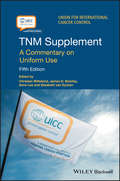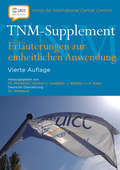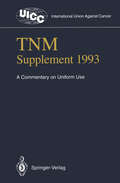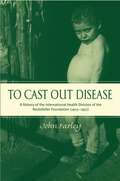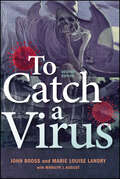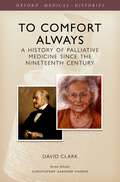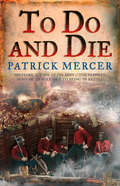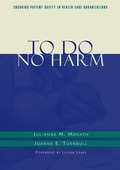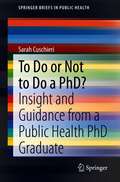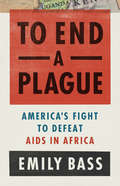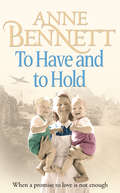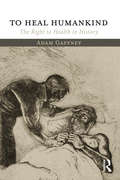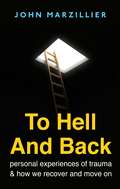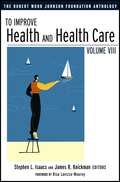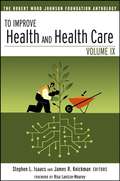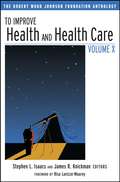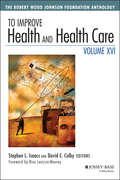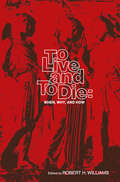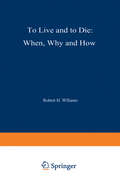- Table View
- List View
TNM Supplement: A Commentary on Uniform Use (UICC)
by Christian Wittekind James D. Brierley Anne Lee Elisabeth Van EyckenThe Union for International Cancer Control's (UICC) TNM classification system is the most widely used cancer classification and staging system in the world. It is used to describe the anatomical extent of disease and it is essential to patient care, research and cancer control. This fifth edition of the TNM Supplement: A Commentary of Uniform Use offers practitioners a wealth of material intended to complement the system's day-to-day use. The volume features: Updated definitions of terms used in cancer staging. New sections on carcinomas of the thymus, sarcomas of the spine and pelvis and soft tissue sarcomas of the head and neck, and comprehensive updates to the head and neck carcinomas, carcinomas of the lung and neuroendocrine tumours sections. Frequently asked questions from the UICC helpdesk. The Supplement may be treated as a companion text to the recent eighth edition of the TNM Classification of Malignant Tumours (978-1-119-26357-9), supporting the correct and uniform application of the TNM classification system. The TNM Supplement can also be utilised as a standalone book, providing explanations and examples to answer many questions that arise during the daily use of the TNM cancer classification and staging system, particularly in unusual cases.
TNM Supplement: A Commentary on Uniform Use (UICC)
by Christian Wittekind James D. Brierley Anne Lee Elisabeth Van EyckenThe Union for International Cancer Control's (UICC) TNM classification system is the most widely used cancer classification and staging system in the world. It is used to describe the anatomical extent of disease and it is essential to patient care, research and cancer control. This fifth edition of the TNM Supplement: A Commentary of Uniform Use offers practitioners a wealth of material intended to complement the system's day-to-day use. The volume features: Updated definitions of terms used in cancer staging. New sections on carcinomas of the thymus, sarcomas of the spine and pelvis and soft tissue sarcomas of the head and neck, and comprehensive updates to the head and neck carcinomas, carcinomas of the lung and neuroendocrine tumours sections. Frequently asked questions from the UICC helpdesk. The Supplement may be treated as a companion text to the recent eighth edition of the TNM Classification of Malignant Tumours (978-1-119-26357-9), supporting the correct and uniform application of the TNM classification system. The TNM Supplement can also be utilised as a standalone book, providing explanations and examples to answer many questions that arise during the daily use of the TNM cancer classification and staging system, particularly in unusual cases.
TNM-Supplement: Erlauterungen zur einheitlichen Anwendung
by Christian Wittekind Carolyn C. Compton Leslie H. Sobin James D. BrierleyWie schon in den vorherigen Supplements ist die 4. Auflage unverzichtbar zur korrekten und einheitlichen Verwendung der Klassifikation von malignen Tumoren. Erstmals wird hier dem Prognostic Factors Project ein Kapitel gewidmet. Unverzichtbar für alle Onkologen und Pathologen.
TNM Supplement 1993: A Commentary on Uniform Use (UICC International Union Against Cancer)
by P. Hermanek, D. E. Henson, R.V.P. Hutter and L.H. SobinThe fourth edition of the TNM Classification was published in 1987,1 and a revision in 1992.2 It was the result of efforts by all national TNM Committees towards a worldwide uniform classification. The classifica tion criteria are identical with the fourth edition of the Manual for 3 Staging of Cancer of the American Joint Committee on Cancer (AJCC). Although the classification has found wide acceptance, some workers have pointed out that individual definitions and rules for staging are not sufficiently detailed. This can lead to inconsistent application of the clas sification. the antithesis of standardization. This source of differences in interpretation applies not only to the classification of individual organs but also to the general rules of the system, especially to the definitions of the requirements for the pathological classification (pT, pN). These are specified only for carcinoma of the breast; for other sites, reference must be made back to the general rules. which can lead to variable interpreta tions. The TNM Project Committee of the UICC has addressed this prob lem and collected and considered the criticisms and suggestions from the national TNM Committees as well as from cancer registries, oncolo gical associations and individual users. The result was the decision to complement the 4th edition of the TN M Classification 1.2. 3 with the publi cation of a TNM Supplement containing recommendations for the uni form use of TNM.
To Break A Doctor's Heart (Mills And Boon Medical Ser.)
by Sharon KendrickMills & Boon are proud to present a thrilling digital collection of all Sharon Kendrick’s novels and novellas for us to celebrate the publication of her amazing 100th book! Many of these books are available as e books for the first time.
To Cast Out Disease: A History of the International Health Division of Rockefeller Foundation (1913-1951)
by John FarleyThough one of the most important public health agencies of the 20th century and the most powerful and richest branch of the Rockefeller Foundation, the International Health Division's history (1913-1951) has never been told before. This original work is based on a vast multitude of letters, reports and photographs the author uncovered in the Rockefeller Archives. Farley describes the internal struggles and the conflicts with foreign and US governments of the "medical barons" who ran the organization as they set its goals and tried to eradicate some of the world's most serious diseases. He also describes the first testing of DDT and the preparation for the US army of a yellow fever vaccine that turned out to be contaminated. He takes the reader into the often byzantine world where the organization endowed schools of public health and nursing in such diverse places as London, Toronto, fascist Rome, militaristic Tokyo, and Calcutta in the dying days of the British Raj. Farley enlivens the book with sketches of the personalities and prejudices of those who worked in the Division and of the scandals that rocked it from time to time. He shows that in the continuing debate between those who believe that disease is the root cause of ill health and poverty and those who see poverty as the primary cause, the Division remained firmly in the former position. He also shows that after it closed, former members exerted considerable influence on the development of the World Health Organization. Opposing some recent historians, Farley argues against the view that the Health Division served as an advance guard for American capitalism. His lively book will be welcomed by all who are interested in the history of public health, tropical disease, and medical institutions.
To Catch A Virus (ASM Books)
by John Booss Marie Louise LandryTo Catch a VirusTrace the evolution of diagnostic virology from yellow fever to COVID-19 Join expert storytellers John Booss, Marilyn J. August, and Marie Louise Landry in a journey through the history of viral epidemics and the detective work of those determined to identify the culprits and treat the infected. From the identification of the first virus in the late 1800s to the molecular techniques that enabled the rapid recognition of and vaccine development for the SARS-CoV-2 virus, viral diagnostic methods have progressed over the past century to become a formidable tool in human health care. This collection of gripping historical narratives covers a range of fascinating outbreaks and public health challenges, from yellow fever and smallpox to AIDS and COVID-19. This new edition chronicles the ongoing story of the COVID-19 pandemic, highlighting the people, the pathogen, and the progress in the diagnostic laboratory and clinical settings that has touched every aspect of global health. The many photographs and rich biographical sketches of key figures, diagrams of diagnostic procedures, micrographs of virus-infected cells, timelines, and a new glossary of key terms make To Catch a Virus compelling reading. This book serves as an excellent resource for courses in virology, immunology, microbiology, and public health. As the world struggles with the ongoing pandemic of SARS-CoV-2/COVID-19, To Catch a Virus is an insightful and superbly told story that chronicles the incredible metamorphosis of diagnostic virology and the technological advances that now make it possible to quickly and accurately detect and monitor the many disease-causing viruses that plague humankind. A stimulating, informative, and absorbing read that is highly recommended.—Richard L. Hodinka, PhD, Professor Emeritus, Perelman School of Medicine at the University of Pennsylvania; former Director, Clinical Virology Laboratory, Children&’s Hospital of Philadelphia To Catch a Virus provides a beautifully written and compelling story of scientific discovery. It carefully traces the understanding of viral diseases from the turn of the twentieth century to the present. For general readers the authors provide timely and expert guidance to the extraordinary advances in diagnosis, surveillance, and therapeutics that constitute the silver lining in the otherwise somber years of COVID-19. For anyone wishing to understand the challenges confronting virologists and their accomplishments to date, this work is the place to start.—Frank M. Snowden, PhD, Andrew Downey Orrick Professor Emeritus of History, Yale University; former Chair, Program in History of Science and History of Medicine, Yale University
To Catch A Virus (ASM Books)
by Marie Louise Landry John BoossTo Catch a VirusTrace the evolution of diagnostic virology from yellow fever to COVID-19 Join expert storytellers John Booss, Marilyn J. August, and Marie Louise Landry in a journey through the history of viral epidemics and the detective work of those determined to identify the culprits and treat the infected. From the identification of the first virus in the late 1800s to the molecular techniques that enabled the rapid recognition of and vaccine development for the SARS-CoV-2 virus, viral diagnostic methods have progressed over the past century to become a formidable tool in human health care. This collection of gripping historical narratives covers a range of fascinating outbreaks and public health challenges, from yellow fever and smallpox to AIDS and COVID-19. This new edition chronicles the ongoing story of the COVID-19 pandemic, highlighting the people, the pathogen, and the progress in the diagnostic laboratory and clinical settings that has touched every aspect of global health. The many photographs and rich biographical sketches of key figures, diagrams of diagnostic procedures, micrographs of virus-infected cells, timelines, and a new glossary of key terms make To Catch a Virus compelling reading. This book serves as an excellent resource for courses in virology, immunology, microbiology, and public health. As the world struggles with the ongoing pandemic of SARS-CoV-2/COVID-19, To Catch a Virus is an insightful and superbly told story that chronicles the incredible metamorphosis of diagnostic virology and the technological advances that now make it possible to quickly and accurately detect and monitor the many disease-causing viruses that plague humankind. A stimulating, informative, and absorbing read that is highly recommended.—Richard L. Hodinka, PhD, Professor Emeritus, Perelman School of Medicine at the University of Pennsylvania; former Director, Clinical Virology Laboratory, Children&’s Hospital of Philadelphia To Catch a Virus provides a beautifully written and compelling story of scientific discovery. It carefully traces the understanding of viral diseases from the turn of the twentieth century to the present. For general readers the authors provide timely and expert guidance to the extraordinary advances in diagnosis, surveillance, and therapeutics that constitute the silver lining in the otherwise somber years of COVID-19. For anyone wishing to understand the challenges confronting virologists and their accomplishments to date, this work is the place to start.—Frank M. Snowden, PhD, Andrew Downey Orrick Professor Emeritus of History, Yale University; former Chair, Program in History of Science and History of Medicine, Yale University
To Comfort Always: A history of palliative medicine since the nineteenth century (Oxford Medical Histories)
by David ClarkPalliative medicine was first recognised as a specialist field in 1987. One hundred years earlier, London based doctor William Munk published a treatise on 'easeful death' that mapped out the principles of practical, spiritual, and medical support at the end of life. In the intervening years a major process of development took place which led to innovative services, new approaches to the study and relief of pain and other symptoms, a growing interest in 'holistic' care, and a desire to gain more recognition for care at the end of life. This book traces the history of palliative medicine, from its nineteenth-century origins, to its modern practice around the world. It takes in the changing meaning of 'euthanasia', assesses the role of religious and philanthropic organisations in the creation of homes for the dying, and explores how twentieth-century doctors created a special focus on end of life care. To Comfort Always traces the rise of clinical studies, academic programmes and international collaborations to promote palliative care. It examines the continuing need to support development with evidence, and assesses the dilemmas of unequal access to services and pain relieving drugs, as well as the periodic accusations of creeping medicalization within the field. This is the first history of its kind, and the breadth of information it encompasses makes it an essential resource for those interested in the long-term achievements of palliative medicine as well as the challenges that remain.
To Comfort Always: A history of palliative medicine since the nineteenth century (Oxford Medical Histories)
by David ClarkPalliative medicine was first recognised as a specialist field in 1987. One hundred years earlier, London based doctor William Munk published a treatise on 'easeful death' that mapped out the principles of practical, spiritual, and medical support at the end of life. In the intervening years a major process of development took place which led to innovative services, new approaches to the study and relief of pain and other symptoms, a growing interest in 'holistic' care, and a desire to gain more recognition for care at the end of life. This book traces the history of palliative medicine, from its nineteenth-century origins, to its modern practice around the world. It takes in the changing meaning of 'euthanasia', assesses the role of religious and philanthropic organisations in the creation of homes for the dying, and explores how twentieth-century doctors created a special focus on end of life care. To Comfort Always traces the rise of clinical studies, academic programmes and international collaborations to promote palliative care. It examines the continuing need to support development with evidence, and assesses the dilemmas of unequal access to services and pain relieving drugs, as well as the periodic accusations of creeping medicalization within the field. This is the first history of its kind, and the breadth of information it encompasses makes it an essential resource for those interested in the long-term achievements of palliative medicine as well as the challenges that remain.
To Do and Die
by Patrick MercerThe historical fiction debut from former soldier, BBC defence correspondent and MP Patrick Mercer is a thrilling military actioner set during the Crimean War.
To Do No Harm: Ensuring Patient Safety in Health Care Organizations
by Julianne M. Morath RN, MS Joanne E. Turnbull PHDWith this important resource, health care leaders from the board room to the point-of-care can learn how to apply the science of safe and best practices from industry to healthcare by changing leadership practices, models of service delivery, and methods of communication.
To Do or Not to Do a PhD?: Insight and Guidance from a Public Health PhD Graduate (SpringerBriefs in Public Health)
by Sarah CuschieriThis book prepares and guides individuals who are about to embark (or already have embarked) on a health/medical PhD journey, with a specific focus on Public Health. Based on the author's experience as a recently graduated Doctor of Philosophy (PhD) student, readers benefit from the knowledge imparted and lessons learned, including an analysis of the different aspects of a Public Health doctoral degree, and practical tips and guidance on how to go about this journey from the initial phase of choosing a research niche up until the oral examination (also called defence). All throughout the book, the author shares examples from her own journey to show that in spite of sacrifices and hurdles along the way, hard work, perseverance, and supportive resources can help see you through, eventually, to a hopefully positive outcome at the end.Using an informal style, the author provides a step-wise guide, from chapter to chapter, on the various essential aspects that need to be considered, including:The initial steps towards a PhDProposal, permissions and fundingThe fieldworkThe art of data analysisThe hurdles along the way – a personal experienceWhat comes after the completion of a PhD?Intended to be a compact go-to guide for students throughout their PhD journey, both from an academic and personal perspective, To Do or Not to Do a PhD? engages readers who are about to enroll in or who already have started a PhD, especially in public health, epidemiology, and health/medical fields of study. The brief also would appeal to postgraduate and undergraduate students who are interested in learning about how to write a research proposal, draft a scientific paper for publication in a journal, or prepare a thesis.
To End a Plague: America's Fight to Defeat AIDS in Africa
by Emily Bass&“Randy Shilts and Laurie Garrett told the story of the HIV/AIDS epidemic through the late 1980s and the early 1990s, respectively. Now journalist-historian-activist Emily Bass tells the story of US engagement in HIV/AIDS control in sub-Saharan Africa. There is far to go on the path, but Bass tells us how far we&’ve come.&” —Sten H. Vermund, professor and dean, Yale School of Public Health With his 2003 announcement of a program known as PEPFAR, George W. Bush launched an astonishingly successful American war against a global pandemic. PEPFAR played a key role in slashing HIV cases and AIDS deaths in sub-Saharan Africa, leading to the brink of epidemic control. Resilient in the face of flatlined funding and political headwinds, PEPFAR is America&’s singular example of how to fight long-term plague—and win. To End a Plague is not merely the definitive history of this extraordinary program; it traces the lives of the activists who first impelled President Bush to take action, and later sought to prevent AIDS deaths at the whims of American politics. Moving from raucous street protests to the marbled halls of Washington and the clinics and homes where Ugandan people living with HIV fight to survive, it reveals an America that was once capable of real and meaningful change—and illuminates imperatives for future pandemic wars. Exhaustively researched and vividly written, this is the true story of an American moonshot.
To Have and To Hold
by Anne BennettA stirring saga of a nurse who only wants to do her duty in World War Two – and who ends up having to make an agonising choice. Set in Ireland and Birmingham, this is the latest from emerging star of the genre Anne Bennett.
To Heal Humankind: The Right to Health in History
by Adam GaffneyThe "human right to healthcare" has had a remarkable rise. It is found in numerous international treaties and national constitutions, it is litigated in courtrooms across the globe, it is increasingly the subject of study by scholars across a range of disciplines, and—perhaps most importantly—it serves as an inspiring rallying cry for health justice activists throughout the world. However, though increasingly accepted as a principle, the historical roots of this right remain largely unexplored. To Heal Humankind: The Right to Health in History fills that gap, combining a sweeping historical scope and interdisciplinary synthesis. Beginning with the Age of Antiquity and extending to the Age of Trump, it analyzes how healthcare has been conceived and provided as both a right and a commodity over time and space, examining the key historical and political junctures when the right to healthcare was widened or diminished in nations around the globe. To Heal Humankind will prove indispensable for all those interested in human rights, the history of public health, and the future of healthcare.
To Heal Humankind: The Right to Health in History
by Adam GaffneyThe "human right to healthcare" has had a remarkable rise. It is found in numerous international treaties and national constitutions, it is litigated in courtrooms across the globe, it is increasingly the subject of study by scholars across a range of disciplines, and—perhaps most importantly—it serves as an inspiring rallying cry for health justice activists throughout the world. However, though increasingly accepted as a principle, the historical roots of this right remain largely unexplored. To Heal Humankind: The Right to Health in History fills that gap, combining a sweeping historical scope and interdisciplinary synthesis. Beginning with the Age of Antiquity and extending to the Age of Trump, it analyzes how healthcare has been conceived and provided as both a right and a commodity over time and space, examining the key historical and political junctures when the right to healthcare was widened or diminished in nations around the globe. To Heal Humankind will prove indispensable for all those interested in human rights, the history of public health, and the future of healthcare.
To Hell and Back: Personal Experiences of Trauma and How We Recover and Move on
by John MarzillierDespite how rare one-off traumatic events may seem, the statistics show that the majority of us are likely to experience such trauma at some point in our lives. In this innovative and engaging book, Marzillier combines first-hand accounts from trauma sufferers with over forty years of clinical practice to provide an honest, human description of how trauma affects us at the time and also after the event. Whether discussing accounts of terrorist bombings, natural disasters, road accidents or physical attacks, he looks at what these experiences do to us and offers practical and consoling advice - for both sufferers and their loved ones - on coping with the experience and developing resilience for the future.
To Improve Health and Health Care: The Robert Wood Johnson Foundation Anthology (Public Health/Robert Wood Johnson Foundation Anthology #24)
by Stephen L. Isaacs James R. Knickman Risa Lavizzo-MoureySince 1972, The Robert Wood Johnson Foundation has been the nation’s largest philanthropy devoted exclusively to health. To further its mission of improving the health and health care of all Americans, the Foundation strives to foster innovation, develop ideas, disseminate information, and enable committed people to devote their energies to improving the nation’s well-being. As part of the Foundation’s efforts to inform the public, To Improve Health and Health Care, the eighth volume in The Robert Wood Johnson Foundation Anthology series, provides an in-depth look into the programs it funds. Written for policy makers and practitioners, as well as interested members of the public, the series offers valuable lessons for leaders and educators developing plans for the coming years.
To Improve Health and Health Care: The Robert Wood Johnson Foundation Anthology (Public Health/Robert Wood Johnson Foundation Anthology #16)
by Stephen L. Isaacs James R. Knickman Risa Lavizzo-MoureySince 1972, the Robert Wood Johnson Foundation has been the nation's largest philanthropy devoted exclusively to health. To further its mission of improving the health and health care of all Americans, the Foundation strives to foster innovation, develop ideas, disseminate information, and enable committed people to devote their energies to improving the nation's well-being. As part of the Foundation's efforts to inform the public, To Improve Health and Health Care, the ninth volume in the Robert Wood Johnson Foundation Anthology series, provides an in-depth look into the programs it funds. Written for policymakers and practitioners, as well as interested members of the public, the series offers valuable lessons for leaders and educators developing plans for the coming years.
To Improve Health and Health Care Volume X: The Robert Wood Johnson Foundation Anthology (Jossey-Bass Public Health #20)
by Stephen L. Isaacs James R. Knickman Risa Lavizzo-MoureySince 1972, the Robert Wood Johnson Foundation has been the nation's largest philanthropy devoted exclusively to health. To further its mission of improving the health and health care of all Americans, the Foundation strives to foster innovation, develop ideas, disseminate information, and enable committed people to devote their energies to improving the nation's well-being. As part of the Foundation's efforts to inform the public, To Improve Health and Health Care, the tenth volume in the Robert Wood Johnson Foundation Anthology series, provides an in-depth look into the programs it funds. Written for policymakers and practitioners, as well as interested members of the public, the series offers valuable lessons for leaders and educators developing plans for the coming years.
To Improve Health and Health Care, Volume XVI: The Robert Wood Johnson Foundation Anthology (Jossey-Bass Public Health)
by Stephen L. Isaacs David C. ColbyThe RWJF's biannual update on the latest developments in U.S. health care To Improve Health and Health Care is the Robert Wood Johnson Foundation's biannual anthology, focusing on the pressing health and health care issues facing the country. This volume covers some of the most important topics in public health, preventative medicine, and health services. Readers will find an in-depth look into the programs funded by the Robert Wood Johnson Foundation, providing policy makers, practitioners, and interested members of the public a valuable perspective to inform strategy for the coming years. As part of the Foundation's efforts to inform the public, this ongoing anthology of the RWJF provides an update on the latest developments and advances taking place in the field of health, bringing readers up to speed on where we are, and where we still need to go. Understand the new developments in reducing childhood obesity Examine innovations in health care delivery Learn how RWJF programs are making a difference to patients and providers Since 1972, the Robert Wood Johnson Foundation has been the nation's largest philanthropy devoted exclusively to health. To further its mission of improving the health and health care of all Americans, the Foundation strives to foster innovation, develop ideas, disseminate information, and enable committed people to devote their energies to improving the nation's well-being. To Improve Health and Health Care describes the latest outcomes and progress, for a complete overview of the American health care system.
To Improve Health and Health Care, Volume XVI: The Robert Wood Johnson Foundation Anthology (Jossey-Bass Public Health)
by Stephen L. Isaacs David C. ColbyThe RWJF's biannual update on the latest developments in U.S. health care To Improve Health and Health Care is the Robert Wood Johnson Foundation's biannual anthology, focusing on the pressing health and health care issues facing the country. This volume covers some of the most important topics in public health, preventative medicine, and health services. Readers will find an in-depth look into the programs funded by the Robert Wood Johnson Foundation, providing policy makers, practitioners, and interested members of the public a valuable perspective to inform strategy for the coming years. As part of the Foundation's efforts to inform the public, this ongoing anthology of the RWJF provides an update on the latest developments and advances taking place in the field of health, bringing readers up to speed on where we are, and where we still need to go. Understand the new developments in reducing childhood obesity Examine innovations in health care delivery Learn how RWJF programs are making a difference to patients and providers Since 1972, the Robert Wood Johnson Foundation has been the nation's largest philanthropy devoted exclusively to health. To further its mission of improving the health and health care of all Americans, the Foundation strives to foster innovation, develop ideas, disseminate information, and enable committed people to devote their energies to improving the nation's well-being. To Improve Health and Health Care describes the latest outcomes and progress, for a complete overview of the American health care system.
To Live and To Die: When, Why, and How
by Robert H. WilliamsIn the 1960's marked changes occurred throughout the world in philosophies and policies related to man's role in life. These changes, prompted predominantly by extensive increases in knowledge and popula tion density, have produced increased pleasures as well as problems. The rising number of people and improved methods of communication and transportation have caused more relationships among people, with their pleasures, competitions, jealousies, conflicts of interest, oppressions, and crimes. Large assortments of drugs have been developed and are easily obtained. There are drugs to speed us up, slow us down, make us sleep, change our perspectives on life, promote propagation of life or prevent it, prolong life or terminate it, and modify the course of life in many ways. Also, numerous mechanical devices have been developed that influence the propagation of life, the termination of life, and the manner in which we live. Many people have changed their overall goals in life, and in par ticular have experienced major changes in attitudes and policies applying to sexual activity, marriage, birth control, abortion, welfare, children, old people, criminals, economics, social status, careers, education, euthanasia, and suicide. There also has been marked enlightenment concerning the effect of the chemical and physical status of the brain upon normal and abnormal thinking and behavior.
To Live and to Die: When, Why, and How
by Robert H. WilliamsIn the 1960's marked changes occurred throughout the world in philosophies and policies related to man's role in life. These changes, prompted predominantly by extensive increases in knowledge and popula tion density, have produced increased pleasures as well as problems. The rising number of people and improved methods of communication and transportation have caused more relationships among people, with their pleasures, competitions, jealousies, conflicts of interest, oppressions, and crimes. Large assortments of drugs have been developed and are easily obtained. There are drugs to speed us up, slow us down, make us sleep, change our perspectives on life, promote propagation of life or prevent it, prolong life or terminate it, and modify the course of life in many ways. Also, numerous mechanical devices have been developed that influence the propagation of life, the termination of life, and the manner in which we live. Many people have changed their overall goals in life, and in par ticular have experienced major changes in attitudes and policies applying to sexual activity, marriage, birth control, abortion, welfare, children, old people, criminals, economics, social status, careers, education, euthanasia, and suicide. There also has been marked enlightenment concerning the effect of the chemical and physical status of the brain upon normal and abnormal thinking and behavior.
